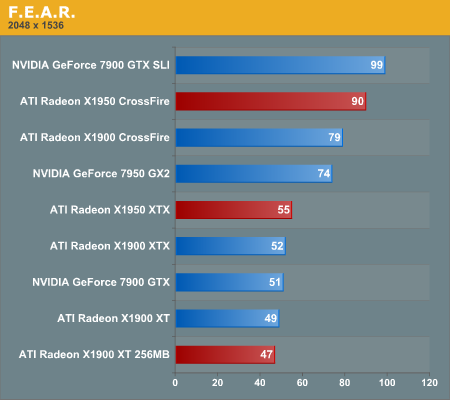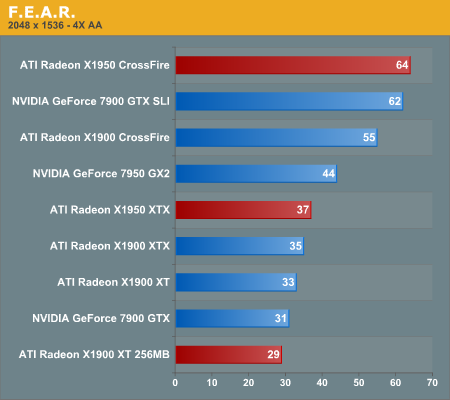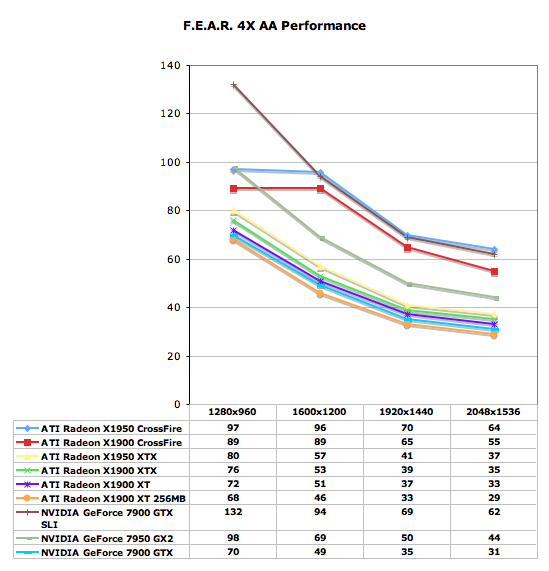ATI's New High End and Mid Range: Radeon X1950 XTX & X1900 XT 256MB
by Derek Wilson on August 23, 2006 9:52 AM EST- Posted in
- GPUs
F.E.A.R. Performance
F.E.A.R. has a built in test that we make use of in this performance analysis. This test flies through some action as people shoot each other and things blow up. F.E.A.R. is very heavy on the graphics, and we enable most of the high end settings for our test.
During our testing of F.E.A.R., we noted that the "soft shadows" don't really look soft. They jumped out at us as multiple layers of transparent shadows layered on top of each other and jittered to appear soft. Unfortunately, this costs a lot in performance and not nearly enough shadows are used to make this look realistic. Thus, we disable soft shadows in our test even though its one of the large performance drains on the system.
Again we tested with antialiasing on and off and anisotropic filtering at 8x. All options were on their highest quality with the exception of soft shadows which was disabled. Frame rates for F.E.A.R. can get pretty low for a first person shooter, but the game does a good job of staying playable down to about 25 fps.

F.E.A.R. returns to NVIDIA's 7900 GTX SLI ruling the top of the charts by 10% over the X1950 CrossFire. What's more noteworthy however is the close to 14% performance boost the X1950 CrossFire gets over the X1900 CrossFire setup, due to its 4% CrossFire card core clock speed boost and faster GDDR4 memory. Once again we see that the 7950 GX2 provides a good middle ground between the price/performance of the fastest single cards and the slowest multi-card multi-GPU setups.
Single card performance, with the exception of the GX2, is pretty close between the top contenders. The X1950 XTX is fastest but its predecessor and the 7900 GTX are not far behind. Even the X1900 XT 256MB puts out a respectable frame rate here, but it's starting to show its limits.

Without AA, nearly every configuration scales exactly the same from low resolution to high. The X1900 CrossFire score at 1280x960 is a little strange, but we confirmed the test a couple different times to make sure nothing was off. It is possible that this scaling issue is due to the lower memory clock, but we really aren't sure why we see the performance we do here. Luckily, there's no need to play at such a low resolution with a $1000 set of graphics cards.

With AA enabled, ATI gains a small advantage over NVIDIA at the very high end with its X1950 CrossFire. The standings mostly remain the same through the rest of the charts, although the 7900 GTX and 512MB X1900 XT swap places in the single card comparisons.
With single cards able to offer playable performance at 2048 x 1536 with 4X AA, we can't wait to see what the next generation of GPUs will bring us in terms of single card performance. Or, alternatively, what game developers are going to be able to do with this much power at their disposal.

The AA graph looks even stranger than the non-AA graph. Both multi card ATI solutions hit a very strange limitation at 1280x960. This isn't a traditional, easy to explain, CPU limitation. A faster memory clock on the X1950 XTX gives it an advantage at 1280x960, and the 7900 GTX SLI has no problem reaching up over 130 fps. Again, we ran this test multiple times and decided to chalk it up to mysterious and unknown driver issues. Other than these anomalies, everything else scales similarly and nothing really trades places at any point in this test.










74 Comments
View All Comments
Ecmaster76 - Wednesday, August 23, 2006 - link
Is it a GDDR3 or a DDR2 product?If the former, any chance it will crossfire with x1600 xt? Oficially I mean (methinks a bios flash might work, though x1650 is maybe a 80nm part)
coldpower27 - Wednesday, August 23, 2006 - link
No I don't think that would work.an X1650 Pro has 600/1400 Speeds so 100% sure is GDDR3, DDR2 doesn't exisit at such high clockspeed.
Genx87 - Wednesday, August 23, 2006 - link
Some of the other reviews had this x1950XT beating the GX2 almost every time, sometimes by a wide margin.I still cant get over the power\transistor\die size to performance advantage Nvidia has over ATI right now.
PrinceGaz - Wednesday, August 23, 2006 - link
Interesting. The first review I read was at where the X1950XTX beat or equalled the 7950GX2 every time, then here the reverse is true. I think I'll have to read more reviews to decide what is going on (it certainly isn't CPU limitations). Maybe 's focus on optimum quality settings rather than raw framerate is the reason they favoured ATI, and another is the clear fact that when it came to minimum framerates instead of average framerates ( posted both for all tests) the X1950XTX was especially good.In other words the 7950GX2 posted great average numbers, but the X1950XTX was playable at higher quality settings because the minimum framerate didn't drop so low. Hopefully some other sites also include minimum framerates along with graphs to clearly show the cards perform.
I remember a few years ago when ATs graphics card articles included image-quality comparisons and all sorts of other reports about how the cards compared in real-world situations. Now it seems all we get is a report on average framerate with a short comment that basically says "higher is better". Derek- I strongly suggest you look at how test cards and the informative and useful comments that accompany each graph. There may only have been three cards in their comparison but it gave a much better idea of how the cards compare to each other.
Anyway I'll not be getting any of these cards. My 6800GT has plenty of performance for now so I'll wait until Vista SP1 and the second-generation of DX10 cards which hopfully won't require a 1KW PSU :)
PrinceGaz - Wednesday, August 23, 2006 - link
It seems the comments system here uses the brackets in HardOCP's abbreviation as some sort of marker. Apologies for making the rest of the text invisible, please amend my comment appropriately. I was talking about HardOCP by the way, when I said they use minimum framerates and optimum quality settings for each card.JarredWalton - Wednesday, August 23, 2006 - link
Don't use {H} in the comments, please. Just like {B} turns on bold, {H} turns on highlighting (white text).
JarredWalton - Wednesday, August 23, 2006 - link
Ah, seems you figured that out already. ;) I need to see if we can disable that feature....haris - Wednesday, August 23, 2006 - link
Actually if you look at all of the reviews a bit more closely the sites the scores depend on which processor is being used for the test. It appears that nVidia cards tend to run better on Conroes(probably just means the games are slightly less cpu bottlenecked at the resolutions being tested) while ATi tends to run better on AMD systems(or when the cpu is slowing things down) Of course that is IIRC from the 5 reviews I skimmed through today.coldpower27 - Wednesday, August 23, 2006 - link
No just no X1950 XTX alone is not more powerful then the 7950GX2. Only in ATI favourable scenarios or where SLI flat out doesn't work will this occur.UNESC0 - Wednesday, August 23, 2006 - link
you might want to run dual monitors...